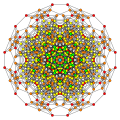| Cantic 8-cube | |
|---|---|
 D8 Coxeter plane projection | |
| Type | uniform 8-polytope |
| Schläfli symbol | t0,1{3,35,1} h2{4,3,3,3,3,3,3} |
| Coxeter-Dynkin diagram | |
| 7-faces | |
| 6-faces | |
| 5-faces | |
| 4-faces | |
| Cells | |
| Faces | |
| Edges | |
| Vertices | |
| Vertex figure | ( )v{ }x{3,3,3,3} |
| Coxeter groups | D8, [35,1,1] |
| Properties | convex |
In eight-dimensional geometry, a cantic 8-cube or truncated 8-demicube is a uniform 8-polytope, being a truncation of the 8-demicube.









